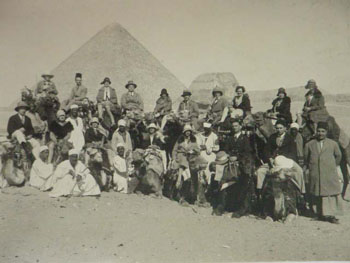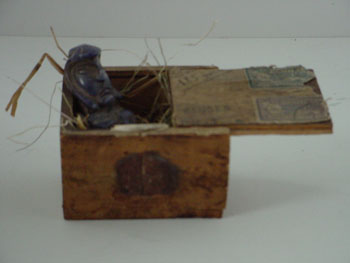Early history of the Surnateum
It all began in the last quarter of the 19th century and continues
into the present day; a world of adventure, where expeditions to far-flung
lands and exotic dangers; a world where all-powerful 'reason'
replaces and conceals any other view of reality.
People tend to think they can understand and explain everything. Our gods are
long dead and buried forever in the sands of yesteryear,
replaced by omniscient man. An anthropocentric vision of creation
divides the world into 'civilised' and 'primitive', a world in which the most
advanced person is called a 'gentleman'.
Legendary cities were uncovered - Troy, Tikal, Knossos, Ur of Chaldea
and Machu Pichu. Multiple discoveries were made, each one very different
from the next.
Courageous explorers and reckless adventurers scoured the most
mysterious corners of the globe. Some of their names were Arminius
Vambéry, Henry Morton Stanley, Schliemann, David Livingstone, Aleister
Crowley, Alexandra David-Neel, Jack London and Howard Carter - to
name just a few. They returned from their exploits with fabulous
tales capable of stirring the imagination.

For the less rash amongst them, a number of secret
societies and occult groups were created in Europe: from the Golden Dawn
to Astrum Argentum, from the Theosophical Society to spiritualist
circles, along with the Temple of Al, the Martinists, the Rose+Croix,
the Worshippers of the Sixth Wound of Christ, various Masonic groups,
multitudes of esoteric sects and groups offering armchair adventurers
the thrill of the forbidden and the illusion of controlling cosmic
forces. At these meetings, scraps of ancient knowledge are exchanged
and discussed by cranks and charlatans such as Eliphas Lévi, Sâr
Péladan, Eugène Vintras, Zanne, H.P. Blavatsky and P.B. Randolph,
pieces of ancient rituals are played out like works of theatre,
without worrying about what could happen. The only thing that
counts is wearing the gaudiest, most ridiculous outfits and
adopting the most pompous titles: Archmagus Ipssissimus, Sâr, Kadosh
the Knight and the Unknown Superior.
Soon, strange objects from exotic tombs, forbidden sanctuaries and
forgotten monasteries began invading private collections and cabinets
of curiosities across Europe. Egyptian and Peruvian mummies,
statuettes of unknown gods, cursed weapons discovered in ancient
Burmese temples and extremely rare books of spells fell into the hands
of reckless individuals incapable of controlling the forces they
contained. After all, money can buy everything, even the illusion of
holding power over the world. The fragile imbalance that man had
maintained with the cosmos for millennia was upset. The vertical
dimension of man, the dimension binding him to the divine, was lost.

And of course, problems appeared: ancient curses
caused the most unexpected disasters, unexplained fires destroyed
museums and exhibitions, mysterious killers terrorised London, Paris,
Düsseldorf and Brussels, inexplicable shipwrecks swallowed up the
titans of the sea and skies, incomprehensible suicides made the
front-page headlines. Incomplete rituals opened
forbidden doors that could not be closed again. Certain obscure
divinities, thirsty for human blood, were only too happy to cross the
threshold and feast at the party...
Panicking collectors began to get rid of cumbersome artifacts. The
most reckless amongst them destroyed them and suffered an appalling
backlash; others sold their artefacts to other victims or donated them
to museums, but were still not spared.
Some of these collectors turned in desperation to the 'Collector', the
first in a long line of Surnateum Collectors!
As an individual who was extremely sensitive to the magical influences
emanating from haunted antiques (hauntiques), he set about
studying the rites used to control the powers of these objects. He
delved into the most disturbing shamanist techniques, became and adept
of voodoo (which he considered the richest and most 'alive' religion
of his time) and, above all, developed an extraordinary empathy with the
universe in which he lived.
Since this task exceeded the exceptional capacities of this one
man, he put together a team of 'sensitives', all
open-minded and blessed with relatively unusual gifts. Such well known
figures as Charles Fort and Jacques Bergier were at one time
associated with the Surnateum and with the various Collectors.
As the decades passed, the collection became so large that it became
necessary to find a permanent physical space for it, a sanctuary: a
Museum of Supernatural History (the Surnateum for short).
In addition to working on the 'donations' made to the museum, the staff
started tracking down haunted objects around the world. Where possible,
these objects are
returned to where they came from; otherwise they are kept in the
sanctuary.
This amazing collection was coveted by the powerful: Heinrich Himmler,
who would stop at nothing to get hold of certain occult treasures; just as Baron von Ungern-Sternberg and Nicholas II had dreamed of doing before him.
And if you doubt that magic can be used these days to enslave a
people, then take a closer look at the corridors of power in the reign
of Mobutu Sesse Seko, 'King of Zaire'. Or just look at what happened when
the Taliban, installed in power by the Americans, destroyed two giant
statues of the Buddha. Before long, the Taliban disappeared. Was that
just
a coincidence?
The heritage of the Surnateum is handed down from one initiate to
another, from one Sensitive to another, from one Collector to the
next.
It is worth noting that other strange collections and psychic museums
exist or have existed in the past. Examples include the Psychic Museum
founded in 1925 by Sir Arthur Conan Doyle, the Horniman museum, which
contains a massive anthropology collection illustrating magic, types
of worship and religions from around the world, and the Cumming museum devoted to
the history of Southwark (South London), which is home to the
Lovett
collection focusing on London superstitions. The collection at 'La
Casa de Leon' in Fredericksburg, Texas, was recently auctioned off for
some $10 million, and the Ripley museums exhibit their stunning
collections around the world. The Antwerp museum of ethnography
sometimes hosts strange collections and the Volkskundemuseum (also in
Antwerp) has a small area devoted to 'superstitions', where one can
admire a superb flute played by rat charmer. And as for the Louvre and
its ghosts, that's a whole other story...

